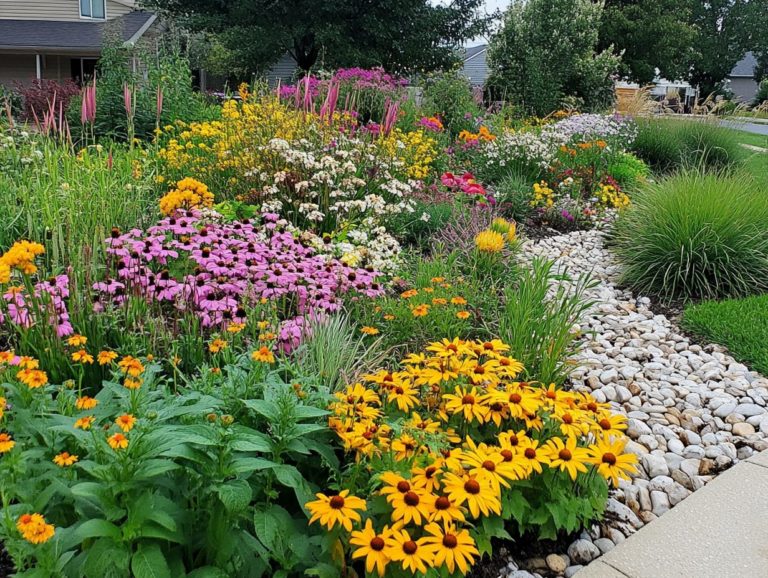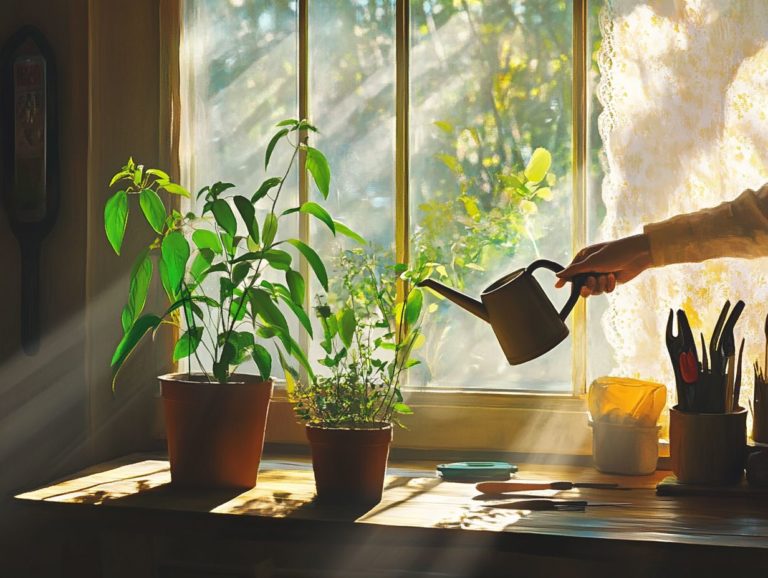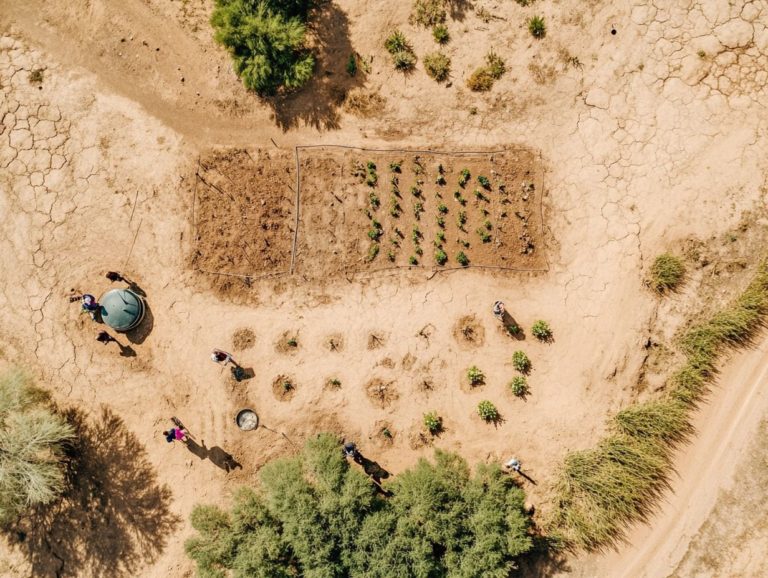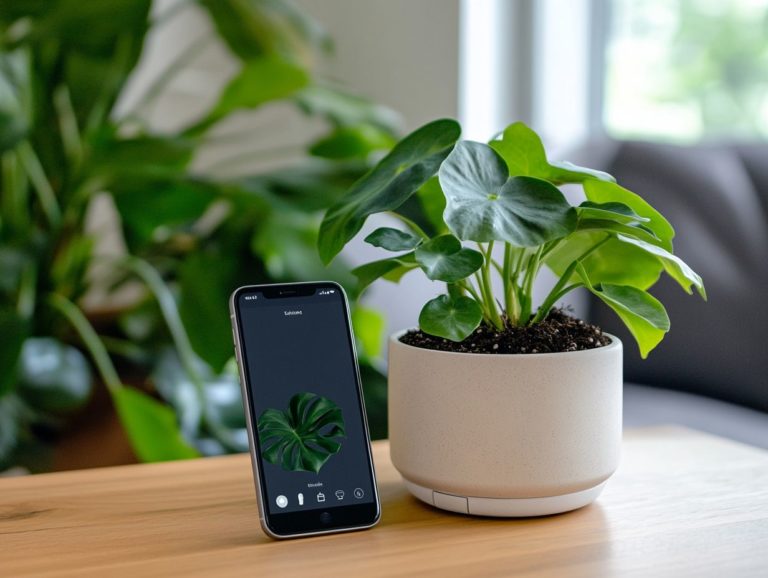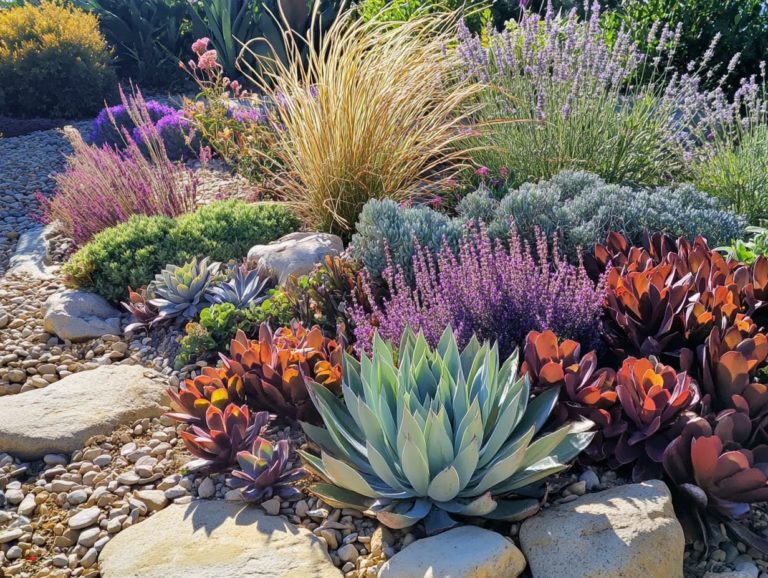Common Mistakes in Drought Plant Care
Are you struggling to keep your drought-resistant plants healthy? Caring for drought-resistant plants can be a truly rewarding experience, yet even the most seasoned gardeners can occasionally stumble into watering mistakes that may impede their growth.
From overwatering to selecting the wrong soil, these common missteps can lead to rather frustrating outcomes for plant health. This guide will empower you to sidestep those pitfalls, ensuring your plants thrive even in the most challenging conditions.
You ll discover essential garden tips on proper watering, drainage, sunlight, and much more to help your garden flourish.
Prepare to cultivate your green thumb!
Contents
- Key Takeaways:
- 1. Overwatering
- 2. Not Providing Adequate Drainage
- 3. Using the Wrong Soil
- 4. Not Providing Enough Sunlight
- 5. Not Pruning Regularly
- 6. Not Fertilizing Correctly
- 7. Using Chemical Pesticides
- 8. Not Mulching
- 9. Ignoring Signs of Pests or Diseases
- 10. Planting Incompatible Plants Together
- 11. Not Rotating Crops
- 12. Not Providing Adequate Space for Growth
- 13. Neglecting to Water Deeply and Infrequently
- 14. Not Protecting Plants from Extreme Temperatures
- 15. Not Researching Proper Care for Specific Plants
- Frequently Asked Questions
- What are some common mistakes in drought plant care?
- How often should I water my drought-resistant plants?
- Can I still water my plants during a drought?
- Is it better to underwater or overwater drought-resistant plants?
- Should I fertilize my drought-resistant plants?
- How can I save a drought-resistant plant that has been overwatered?
Key Takeaways:
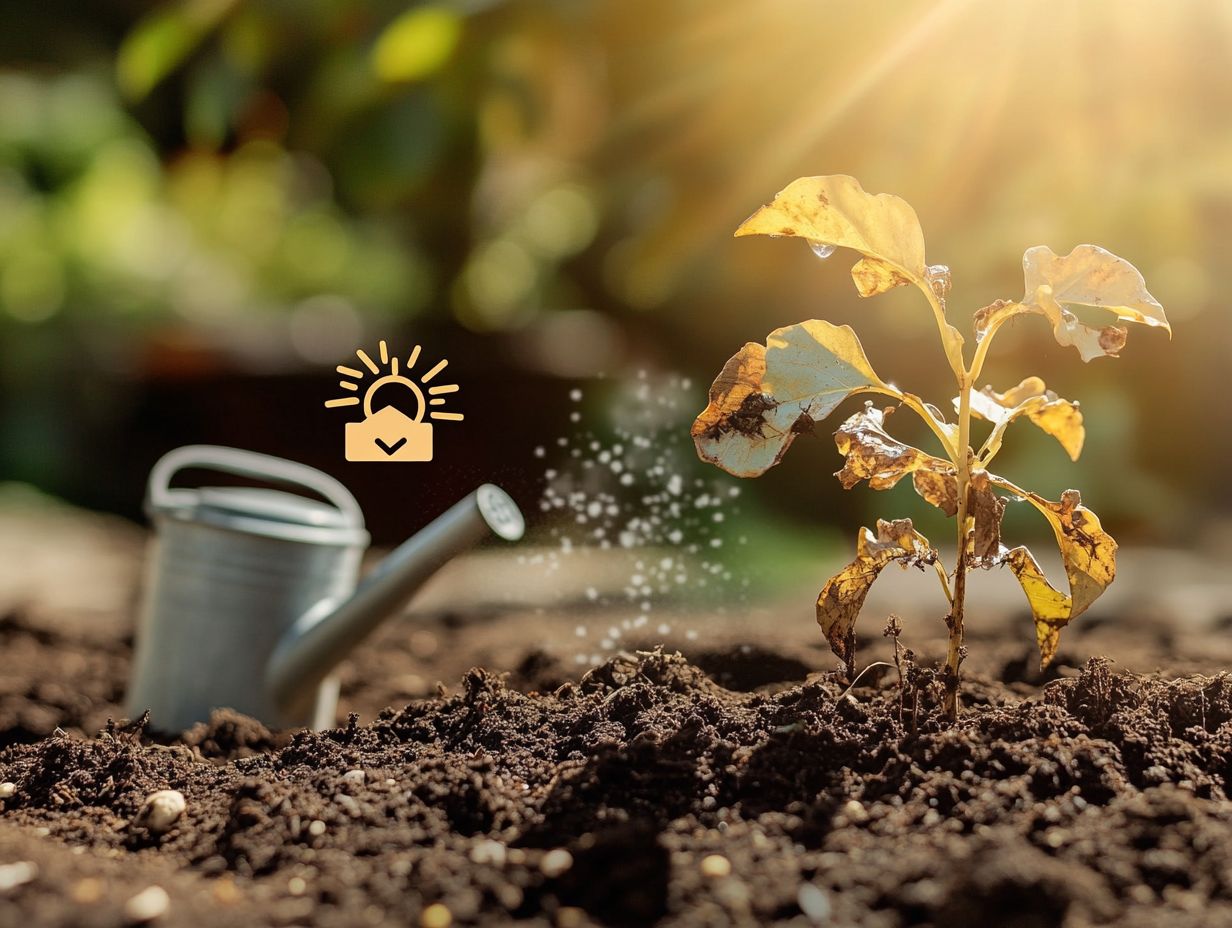
- Avoid overwatering drought plants to prevent waterlogging and root rot.
- Ensure proper drainage to prevent water buildup and root damage.
- Use well-draining soil specifically made for drought-tolerant plants.
1. Overwatering
Overwatering stands as one of the most prevalent pitfalls in plant care. This can drastically impact your plants’ health and may cause root rot and too much water, ultimately undermining the vitality of your entire garden. To avoid such issues, consider following guidelines on how to create a drought plant care plan.
Mastering the art of proper watering techniques is crucial for ensuring your plants not only survive but thrive, steering clear of the perils that excessive moisture can bring.
You might also see signs of overwatering manifesting in leaf discoloration. When leaves shift from their vibrant green hue to shades of yellow or even brown, it s a clear reflection of the plant’s distress.
Moreover, you might notice wilting leaves, even in the presence of soggy soil. This often indicates that the roots have become so saturated that they re unable to take in nutrients effectively. As waterlogged roots begin to rot, their capacity to transport essential nutrients dwindles, leading your plants into further decline.
To prevent these dilemmas, it s vital to embrace proper watering techniques. Allow the top inch of soil to dry between waterings and ensure that your pots are equipped with adequate drainage. By doing so, you create a healthier environment conducive to robust growth.
2. Not Providing Adequate Drainage
Neglecting adequate drainage can have serious repercussions for plant health. When soil drainage is poor, water tends to accumulate, leading to waterlogged roots that hinder the plant’s ability to effectively absorb nutrients.
This not only stunts growth but also heightens vulnerability to diseases and pests. Therefore, understanding the critical role proper drainage plays in your watering routine is essential.
To enhance drainage, consider incorporating organic matter like compost into the soil; this will improve both structure and aeration.
- Adding sand or perlite can further facilitate better water movement.
- Raising garden beds can help prevent water from pooling around those delicate roots.
Regularly monitoring moisture levels and adjusting your watering frequency based on rainfall will foster a thriving, healthy garden ecosystem.
3. Using the Wrong Soil
Using the wrong soil can severely compromise plant health, impacting both moisture retention and nutrient availability two elements that are crucial for nurturing a thriving garden.
Healthy soil is typically rich in organic matter, maintains a balanced pH level, and hosts a diverse microbial population, all of which work together to promote robust plant development.
Understanding the specific needs of different plants is vital; for instance, cacti flourish in sandy, well-draining soil, while ferns thrive in a loamy mix that effectively retains moisture.
Crafting a proper soil mix not only enhances water retention but also improves nutrient absorption, creating the perfect environment for your greenery to thrive. By prioritizing these essential soil characteristics, you can ensure that your plants grow strong and resilient, ultimately resulting in a more vibrant and flourishing landscape.
Start using these tips today to unlock the full potential of your garden!
4. Not Providing Enough Sunlight
Not providing sufficient sunlight is a critical misstep that can hinder plant growth and compromise their overall health. Adequate lighting is essential for photosynthesis, the process through which plants convert light into energy, and the vitality of your plants.
To create the perfect environment for flourishing greenery, it’s important to recognize that different species have distinct light requirements. Drought-tolerant plants, for instance, often thrive in bright, direct sunlight and partial shade. This adaptability allows them to thrive in various gardening conditions.
As a gardener, evaluate the sunlight patterns in your space, paying close attention to the intensity and duration of light throughout the day. Incorporating reflective materials, like light-colored stones or mulch, can significantly enhance sunlight exposure. This ensures that these resilient plants flourish beautifully in their chosen spots.
5. Not Pruning Regularly
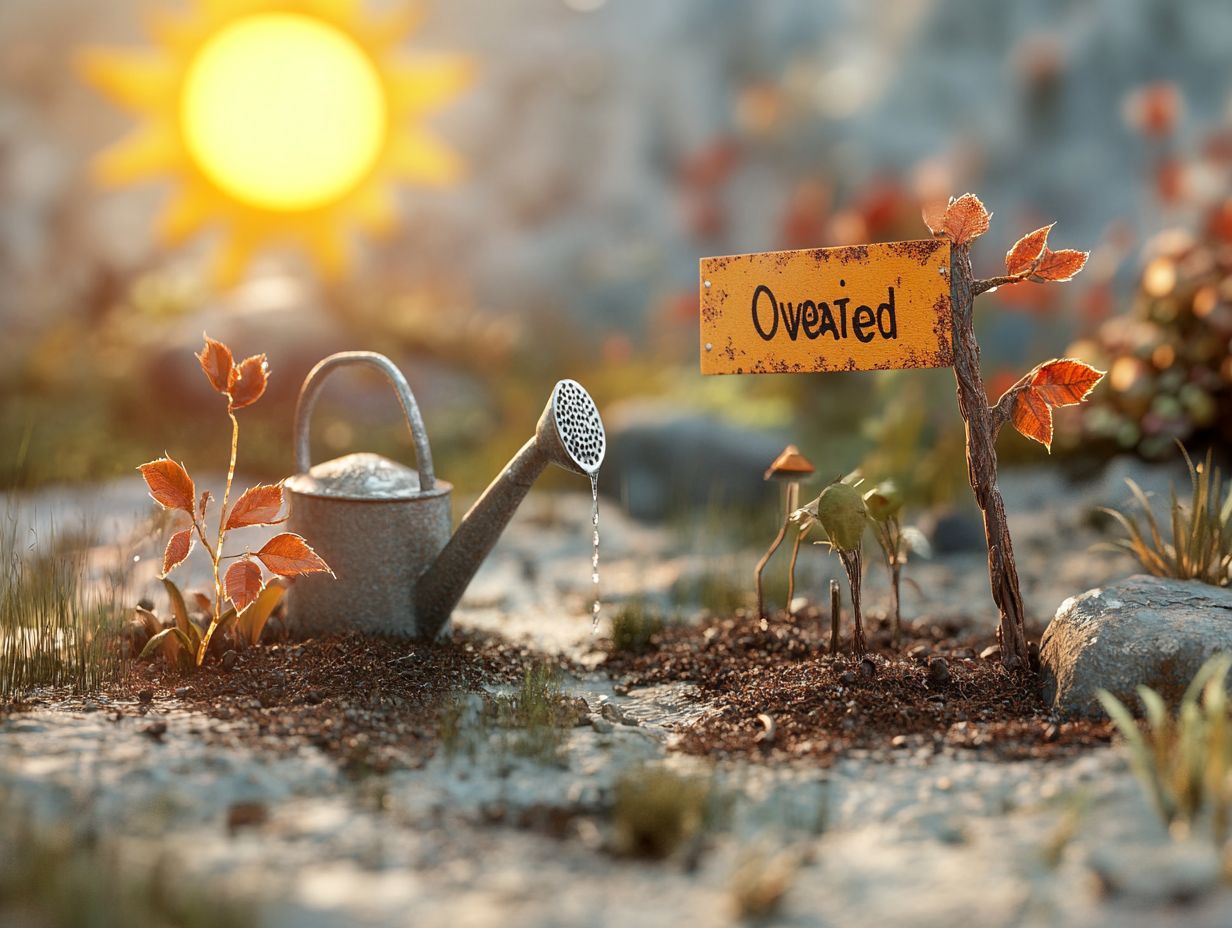
Regular pruning is essential for maintaining healthy plants. It encourages vigorous growth and enhances pest prevention by improving air circulation and reducing susceptibility to diseases.
Explore various pruning techniques: thinning, heading, and rejuvenation. Each technique is tailored to different growth cycles and contributes uniquely to your plants’ health. Thinning allows light and airflow to penetrate, which is crucial during the active growing season.
Heading can stimulate bushier growth when your plants are in their dormant phase. Rejuvenation pruning is particularly important for older plants, helping them regain their health and vitality.
When you execute proper pruning practices, you don t just shape your plants aesthetically; you also fortify their resilience against environmental stressors. This ensures lush foliage and robust health throughout their lifespan.
6. Not Fertilizing Correctly
Neglecting proper fertilization can lead to nutrient deficiencies that compromise plant health, growth, and resilience. Understanding what your plants need and selecting the right natural fertilizers is essential for healthy growth.
By choosing natural fertilizers and compost, you enhance soil structure and microbial activity. This also reduces the risk of harmful chemical runoff, nurturing a healthier ecosystem. These organic options release nutrients gradually, providing a steady supply that matches the specific nutritional requirements of your plants.
When you tailor your fertilization to meet these needs, you can significantly boost plant vitality and yield. This paves the way for a more sustainable gardening approach that champions biodiversity and long-term soil health.
Pair these methods with regular composting to create an even more thriving garden environment.
7. Using Chemical Pesticides
Relying on chemical pesticides may seem like a quick fix, but it can harm not just the target pests but also the health of your plants and the surrounding ecosystem. Opting for natural alternatives, such as companion planting, is a far more sustainable choice!
The widespread use of synthetic chemicals can disrupt beneficial insect populations, creating an imbalance in the ecosystem that leaves your plants vulnerable to more severe infestations. Residues from these pesticides can leach into the soil and waterways, negatively impacting wildlife and contaminating drinking supplies.
Instead of turning to harsh chemicals, consider embracing organic treatments and strategies that foster a healthier environment. Introducing specific plants that attract beneficial insects can create a robust defense against pests.
By promoting biodiversity and utilizing natural treatments, you can effectively safeguard your plants while nurturing a thriving ecosystem. Are your plants getting enough sunlight? Check your plants’ sunlight needs today!
8. Not Mulching
Skipping mulch can cause weeds to thrive and your plants to struggle. Neglecting to mulch your garden can lead to decreased moisture retention, both of which can seriously compromise plant health and stunt their growth.
By seamlessly incorporating mulch into your gardening routine, you create a formidable barrier that smothers weeds. This allows your desired plants to flourish without the burden of competition. Mulch serves as a protective layer that minimizes evaporation from the soil, which is very helpful during sweltering summer months. Enhanced moisture retention means your plants can spend less time stressed and more time thriving in their ideal growing conditions.
When choosing the perfect mulch, consider organic options like wood chips or straw; these not only protect but also enrich the soil as they break down. Spread a layer that s about 2-4 inches thick around your plants, but keep it a few inches away from the stems to avoid rot.
9. Ignoring Signs of Pests or Diseases
Neglecting the early signs of pests or diseases, like leaf discoloration and wilting, can drastically compromise your plants’ health. If you don’t take action swiftly, it can lead to irreversible damage.
These early signs can be easy to miss in the hustle and bustle of daily life. Heightened awareness becomes your essential first line of defense.
Set up a regular monitoring schedule to keep your plants healthy. This will let you closely inspect your plants, paying special attention underneath leaves and along stems those are the prime hideouts for pests and diseases that affect plant survival. Employ strategies such as changing what you plant in a specific spot each year, using proper lighting techniques, and perfecting your watering methods like drip irrigation to conserve water. Also, consider using organic pest deterrents, including natural fertilizers, which can enhance your plants’ resilience.
Act now to prevent a small issue from becoming a big problem. Embrace a proactive approach to plant care by cleaning leaves to prevent pests. This can dramatically lower the risk of larger infestations and diseases taking root.
10. Planting Incompatible Plants Together
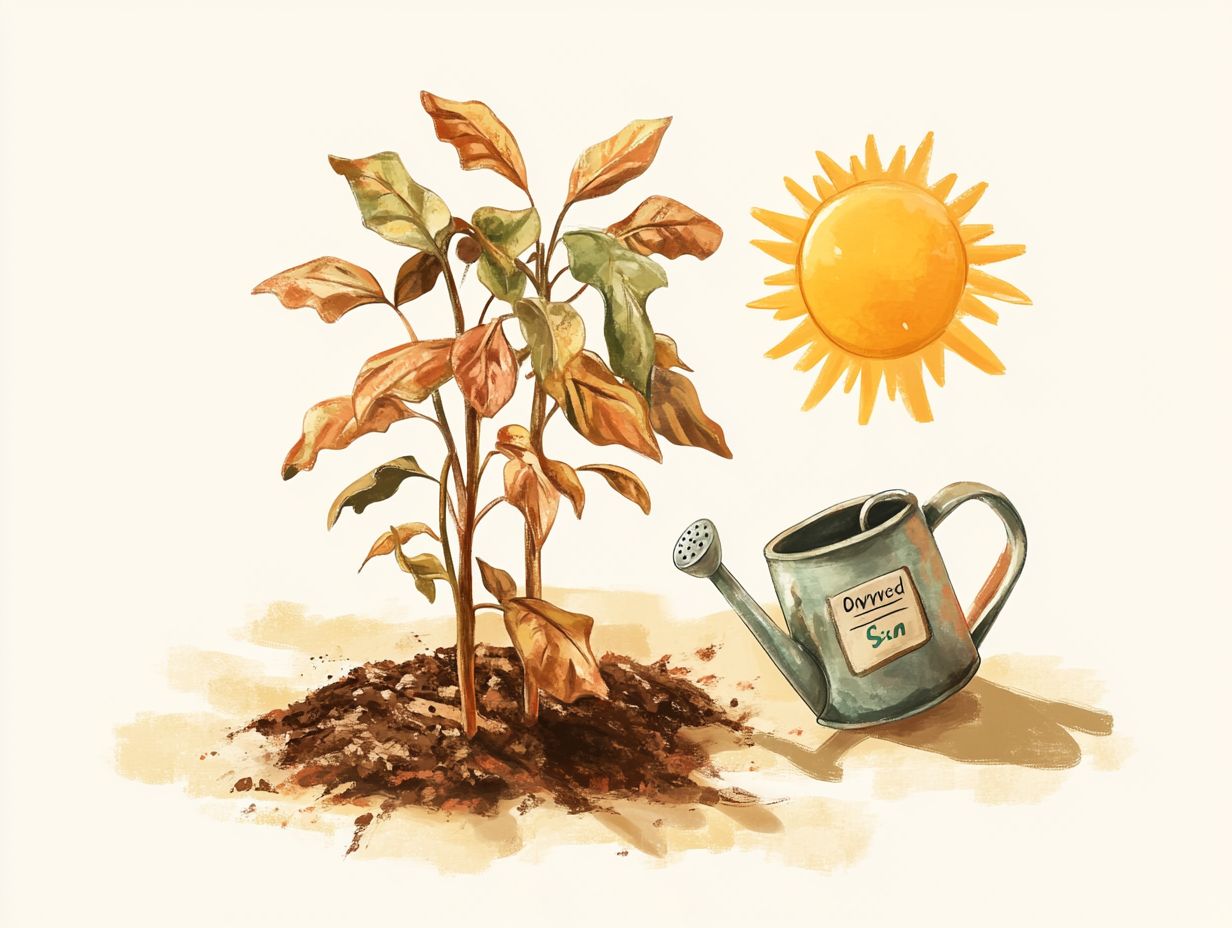
Planting incompatible plants together can throw a wrench in healthy growth. Certain species may compete for resources or attract pests that negatively impact their neighbors. Understanding the specific needs of plants is essential for cultivating a thriving garden.
By recognizing these dynamics, you can create a more harmonious ecosystem where plants not only coexist but also mutually benefit from one another. For instance, tomatoes and basil flourish when planted together; basil enhances the flavor of tomatoes while warding off pests that might otherwise attack them. Conversely, planting onions near beans can be a recipe for disaster, as onions release compounds that inhibit the growth of legumes.
Understanding these relationships is key to creating a vibrant garden! With this knowledge, you can cultivate a resilient garden that truly maximizes the advantages of companion planting, helping with pest prevention.
11. Not Rotating Crops
Neglecting crop rotation can lead to nutrient depletion in your soil and a heightened risk of plant diseases caused by moisture stress, which can cause leaf discoloration. This makes crop rotation essential for cultivating a thriving garden.
When you repeatedly plant the same species in the same spot, you drain specific nutrients and make your plants more vulnerable to pests and diseases. By implementing a systematic rotation plan, you enrich your soil and promote biodiversity, significantly enhancing the overall health of your garden ecosystem.
To effectively rotate your crops, start by grouping plants into families and change them up annually. For example, legumes are fantastic for enriching the soil with nitrogen, so you can follow them with leafy greens or fruits that crave those extra nutrients. Also, consider alternating between deep-rooted and shallow-rooted crops to maximize nutrient uptake.
By adhering to these guidelines, you can cultivate a sustainable environment that stands strong against degradation and disease.
12. Not Providing Adequate Space for Growth
Failing to provide adequate space for growth can seriously hinder the development of your plants. Too many plants close together restricts access to essential resources like water and nutrients, ultimately affecting their growth cycles.
When your plants are too close together, the competition for these vital elements ramps up. This leads to stunted growth and makes them more susceptible to diseases. This is particularly true for species with extensive root systems or broad foliage, such as tomatoes or sunflowers. Ensuring sufficient spacing not only promotes healthier growth but also allows for better air circulation the movement of air around plants and sunlight penetration.
For leafy greens like lettuce, aim for a spacing of 12 to 18 inches to avoid excessive moisture retention. Meanwhile, flowering plants like marigolds thrive when spaced 10 to 12 inches apart, allowing them to flourish without hindrance!
Understanding these spacing requirements is essential for anyone who wants to maintain a thriving garden.
13. Neglecting to Water Deeply and Infrequently
Neglecting to water deeply and infrequently can lead to shallow root systems and higher mortality rates in your plants. This underscores the necessity of a well-planned watering schedule for their survival!
When you water your plants shallowly and frequently, their roots remain close to the surface. This makes them more susceptible to drought. Deep watering, on the other hand, encourages roots to delve deeper into the soil, where they can access moisture and nutrients more efficiently. This approach not only bolsters the strength and resilience of your plants but also improves moisture retention in the soil.
To establish an effective watering schedule, aim to water in the early morning or late afternoon, allowing moisture to soak in before evaporation takes over.
Incorporating mulch a layer of material on the soil surface that helps retain moisture can significantly enhance moisture retention and foster healthier and more robust growth overall.
14. Not Protecting Plants from Extreme Temperatures
Failing to protect your plants from extreme temperatures can lead to significant stress and compromised health, particularly during drought conditions that can stress your plants. Therefore, it’s essential to implement effective strategies that shield your plants from temperature fluctuations.
To help your plants flourish, consider using protective measures such as shade cloths. These create a barrier against harsh sunlight, significantly reducing the risk of leaf scorch. Additionally, carefully positioning your plants in areas that naturally offer shade like alongside taller structures or trees can help mitigate temperature extremes.
It’s important to monitor temperature conditions. By keeping a close eye on daily fluctuations, you can determine when adjustments to watering or shading are necessary. Together, these efforts establish a comprehensive approach to maintaining optimal growing conditions, ensuring your plants remain vibrant and healthy!
15. Not Researching Proper Care for Specific Plants
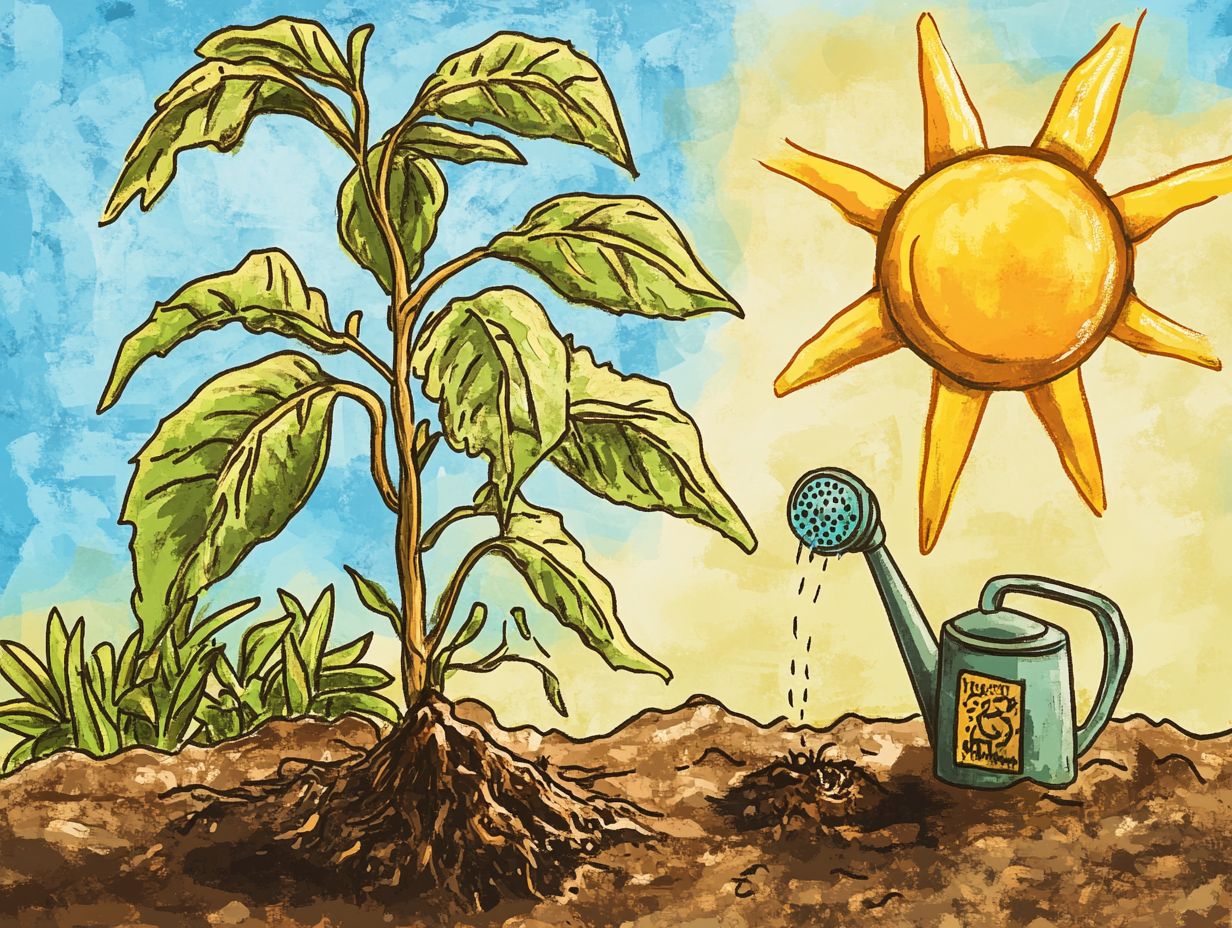
Neglecting to thoroughly research the specific care requirements for your plants can lead to oversight of their unique needs. For instance, understanding the signs of overwatering in drought plants can help prevent health issues that are easily avoidable with the right knowledge and care practices!
Grasping the particular needs of each plant species is essential for cultivating a vibrant garden or indoor oasis. Many enthusiasts tend to overlook the variations in sunlight, water, and soil preferences, which can significantly influence growth.
Leveraging resources like gardening books, online plant care databases, and local gardening clubs can offer invaluable insights into tailored care guidelines. Maintaining a plant care journal can be a practical way to track growth patterns and identify potential issues over time, ensuring your plants receive the attention they require for robust health and vitality.
By thoughtfully integrating these practices, you cultivate a deeper connection with your plants while fostering their flourishing!
Frequently Asked Questions
What are some common mistakes in drought plant care?
Common mistakes include overwatering, which can waterlog the roots. Not giving enough sunlight and failing to adjust watering frequency can also harm your plants. To better understand these issues, check out common mistakes to avoid in drought gardening.
How often should I water my drought-resistant plants?
Watering frequency varies by plant and environment. It’s crucial to research your specific plants and change your watering habits accordingly.
Can I still water my plants during a drought?
Yes, you can water them, but be mindful of your water usage. Use collected rainwater or a drip irrigation system to save water.
Is it better to underwater or overwater drought-resistant plants?
Underwatering is better than overwatering. These resilient plants thrive in dry conditions and can suffer or die from too much water.
Should I fertilize my drought-resistant plants?
Fertilizing can do more harm than good. These plants are built to grow in low-nutrient soil, so adding fertilizer may disrupt their growth and harm their roots.
How can I save a drought-resistant plant that has been overwatered?
If your plant has been overwatered, quickly remove it from its pot and shake off the excess soil. Let it dry out completely before repotting in well-draining soil. Adjust your watering habits to prevent this in the future.

